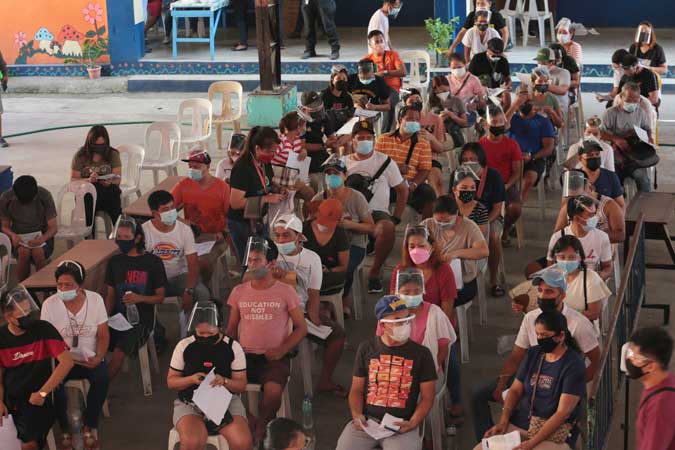THE government placed Metro Manila under general community quarantine “with heightened restrictions” until end-July, in a bid to curb the spread of the Delta variant. — PHILIPPINE STAR/ MICHAEL VARCAS
THE PHILIPPINES is at risk of “long-term economic scarring,” with gross domestic product (GDP) growth expected to slow to around 6% after 2022, Moody’s Investors Service said.
“Pandemic risks have weighed on the Philippines’ economic recovery compared with its more export-oriented peers in the Asia-Pacific, delaying fiscal consolidation and raising the prospects for long-term economic scarring. In particular, the revival of private investment would depend on a sustained restoration of business confidence,” Christian de Guzman, a Moody’s senior vice-president, said in a note on Monday.
The economy shrank by a record 9.6% in 2020 and continued to fall by 4.2% in the first quarter.
Last week, Moody’s lowered its growth forecast for the country to 5.8% this year. It also expects the Philippines’ GDP to grow by 6.5% in 2022.
“Beyond 2022, we expect growth in the Philippines to slow toward a potential of around 6% per annum from the average of around 6.6% in the five-year period preceding the coronavirus outbreak. While this growth is still robust compared with investment-grade peers, the deviation from the preceding trend incorporates a view of limited economic scarring,” he said.
“Economic scarring” may be seen in the country’s labor market and the poverty levels, which had improved prior to the pandemic.
“Weaker economic growth would also make fiscal consolidation more difficult, leaving governments with higher debt burdens for years to come and reducing room to respond to future shocks,” Moody’s said.
Moody’s last affirmed the Philippines’ “Baa2” rating with a stable outlook in July 2020. The stable outlook meant the rating is expected to be kept for the next 12 or 18 months.
“The stable outlook reflects the view that the country’s recovery from the acute pandemic shock will restore rapid economic growth compared with its peers, complemented by the stabilization and eventual reversal of the deterioration in fiscal and debt metrics,” Moody’s said.
But the ratings agency also warned against a scenario where the economy’s potential has been damaged “more significantly” than what it had forecast. It also cautioned against a situation wherein the Philippines’ reforms are not continued which could weaken economic and fiscal strength or both.
In 2019, the debt-to-gross domestic product ratio was at a record low of 39.6%, but this has surged to 60.4% as of end-March.
“[A] greater deterioration in fiscal and government debt metrics relative to peers or an erosion of the country’s external payments position that threatens liquidity conditions could lead to a downgrade,” Moody’s said.
“The reversal of reforms that have supported prior gains in economic and fiscal strength, as well as a substantial deterioration in institutions and governance strength would also be negative,” it added.
PREEMPTIVE MEASURES
Meanwhile, the National Economic and Development Authority (NEDA) stressed the need to roll out preemptive measures amid the elevated economic risks from the more contagious Delta variant of the coronavirus disease 2019 (COVID-19).
“Delta (variant) poses higher risks so we are doing preemptive measures to ensure the health of the people while allowing the economy to function as much as possible,” Socioeconomic Planning Secretary Karl Kendrick T. Chua said in a Viber message on Sunday evening.
With a rise in the local transmission of the Delta variant, there are concerns the government may further tighten lockdown restrictions.
The Health department on Monday reported 6,664 new COVID-19 cases, bringing active cases to 55,140.
NEDA has backed the imposition of localized lockdowns instead of broad quarantine restrictions, citing the need to allow economic activities to continue in areas with low cases of infections.
The government placed Metro Manila and the provinces of Ilocos Norte, Ilocos Sur, Davao de Oro and Davao del Norte under general community quarantine “with heightened restrictions” until end-July, in a bid to curb the spread of the Delta variant.
Think tank Moody’s Analytics said the Philippine economy, similar with India, is facing “considerable downside risks” in the second half and into 2022, largely due to “lengthy economic shutdowns, accompanied by only modest fiscal support provided to SMEs (small and medium enterprises) and low-income households.”
“[This] could lead to very deep and lasting scarring as they struggle to reopen businesses, pay back loans, or find employment as the economy finally recovers,” it said in a note to journalists on Monday.
Philippine economic managers are aiming for a 6-7% growth this year.
The government is expecting 70 million COVID-19 vaccines to be delivered this quarter and 50 million more in the last three months of the year.
Official data showed vaccines administered hit 17.2 million as of Sunday, which included 6.1 million Filipinos already receiving their second dose. — L.W.T. Noble and B.M.Laforga

